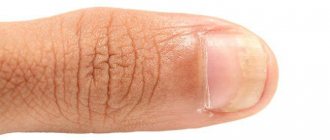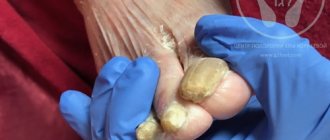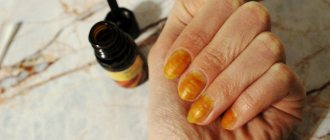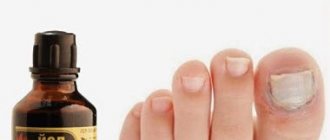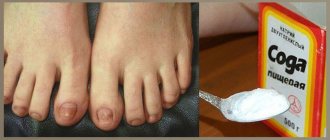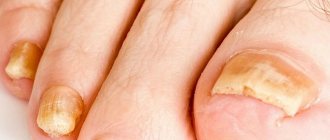Top 10 remedies for treating nail fungus.
May 21, 2022
12996
4.9
3
Content
- Exoderil
- Nizoral
- Lamisil
- Lotseril
- Clotrimazole
- Candide
- Mycoseptin
- Nitrofungin
- Terbinafine
- Mikoderil
Recently, more and more people are turning to dermatologists with a problem such as nail fungus. Symptoms of nail fungus include: peeling and loosening of the nail plate, unpleasant odor from feet and shoes, darkening of nails, etc.
Based on feedback from patients who had nail fungus, we have compiled a list of the most effective ointments and solutions, from which you can choose one product for your home medicine cabinet.
Read also Review of popular drugs against thrush The most popular drugs against thrush for internal and external use
Inexpensive nail removers
Such medications often contain urea, which promotes easy and gentle softening and removal of the nail plate. Perfect for spot removal of the plate; it is not necessary to remove the entire nail:
- Mikostop paste
- available in 20 ml tubes priced from 160 to 200 rubles; - Nogtimitsin cream
- comes in a 30 g package and costs no more than 150 rubles; - Nogtivit cream
— a small tube costing up to 200 rubles; - Fundizol cream
- costs about 100 rubles.
But none of these drugs can be considered an excellent treatment method for advanced cases of fungus.
[media=
https://youtu.be/tYNxqUZftEY
]
Exoderil
The solution for the fungus "Exoderil" contains naftifine - this substance gradually accumulates in the nails affected by the fungus and destroys it. The excipients of the drug help the active components penetrate the nail faster. In addition to the antifungal effect, Exoderil has the ability to relieve inflammation caused by mycosis and relieve itching. Contraindications to the use of the anti-fungal remedy: allergic reactions to the components of the drug, pregnancy, breastfeeding, childhood.
Exoderil
Eczacibasi Ilac Sanayi ve Ticar, Türkiye; Sandoz (Sandoz), Germany; Biochemie GmbH, Austria; Globopharm pharmazeutische Productions, Austria
Naftifine is an antifungal agent for external use, belonging to the class of allylamines.
The mechanism of action is associated with inhibition of squalene-2,3-epoxidase, which leads to a decrease in the formation of ergosterol, which is part of the cell wall of the fungus. Active against dermatophytes such as Trichophyton, Epidermophyton and Microsporum, molds (Aspergillus spp.), yeast fungi (Candida spp., Pityrosporum) and other fungi (for example Sporothrix schenckii). from 464
4.0 1 review
3515
- Like
- Write a review
Onychomycosis (nail fungus) - symptoms and treatment
There are several types of treatment for onychomycosis:
- Local therapy.
- Systemic therapy.
- Combination therapy.
- Corrective therapy [2].
Local therapy involves applying medications to the nail plate and nail folds. Indications for local therapy:
- Limited form of damage to the nail plate (according to KIOTOS [4]).
- There are contraindications for prescribing systemic drugs: hypersensitivity, liver disease, renal dysfunction, pregnancy, lactation.
The advantages of this therapy are that high concentrations of the therapeutic agent are formed on the surface of the nail, which does not penetrate into the bloodstream. There are no side effects of using antifungal drugs - nausea, loss of appetite, abdominal pain. The disadvantage of the method is that the medicinal substance does not always reach the pathogen's habitat, especially if the fungi are located in the nail bed or matrix. This in turn can lead to treatment failure. This type of treatment is very labor-intensive, since before applying the drug it is necessary to remove the affected part of the nail [2].
Methods for removing affected nails:
- Mechanical removal using files, nippers or a drill.
- Using keratolytic patches. Before applying a keratolytic plaster, the skin around the nail is sealed with a plaster, a plaster mass (urea with salicylic acid) is applied on top and sealed with an adhesive plaster. The plaster mass is changed every 2-3 days. After each removal, the affected part of the nail is removed mechanically.
- Surgical. This operation is very painful and traumatic, since when the nail plate is removed, the growth zone can be damaged, which leads to the regrowth of deformed nails.
Local antifungal agents are used after removing the affected nail plate. Antimycotics are distinguished according to the place of application:
- applied to the nail: varnishes;
- applied to rollers: creams, ointments, solutions.
The most studied drug for topical use is a 1% solution of naftifine , which has an evidence base for effectiveness in treatment based on a Cochrane meta-analysis [8]. This product is water-based, which facilitates better penetration of the antifungal substance into the affected area. Varnishes, the active ingredients of which are ciclopirox and amorolfine, have a dehydrated base, which reduces the penetration of the drug into the deep layers. Therefore, dermatologists consider the use of varnishes unsatisfactory and increasingly prefer water-based products [10].
To get results from local therapy, it is necessary to follow the treatment regimen; it is important for the patient to be responsible, consistent and patient. The duration of therapy can be up to 12 months.
Systemic therapy allows the antifungal drug to penetrate the bloodstream to the site of the lesion, even if the nail bed and matrix are affected [2]. A high concentration of the drug remains in the affected area for a long time after the end of use. The disadvantages of this type of treatment are associated with the risk of side and toxic effects.
Indications for systemic therapy:
- Common forms of nail plate damage.
- Lack of effect from local therapy (that is, after six months of treatment for onychomycosis on the hands and 9-12 months of treatment for onychomycosis of the feet, healthy nails did not grow back).
To determine treatment tactics, KIOTOS (Clinical Index for Assessing the Severity of Onychomycosis by Sergeev), proposed by A. Yu. Sergeev in 1999, is used. It is used as a therapeutic standard in various countries around the world [3][4].
Medicines for the treatment of onychomycosis can be classified as follows:
- antimycotics - have an antifungal effect;
- antiseptics - have both antifungal and antibacterial effects. They are rarely used, only if there are no other antifungal agents;
- multicomponent - in addition to the antifungal agent, they also contain other drugs, such as anti-inflammatory drugs.
Prescription regimens:
- standard - taking medications daily during the prescribed treatment period;
- shortened - the treatment period is shortened, can be carried out in regular doses or increased;
- intermittent - treatment is prescribed in several short courses, the intervals between courses are equal to the duration of the courses;
- pulse therapy - treatment is prescribed in several short courses, the intervals between courses are longer than the duration of the courses [3].
Antifungal drugs are divided according to the active substance:
- triazoles: itraconazole, fluconazole;
- allylamines: terbinafine, naftifine;
- others: ciclopirox, morpholines [3].
Currently, only third-generation drugs : terbinafine, itraconazole, fluconazole.
Terbinafine acts only on dermatophytes, is highly effective and safe. This drug must be taken every day for a long period of time [2][3].
Itraconazole - covers all types of pathogens of onychomycosis. It accumulates best in the nail. Used in short courses. Highly effective and has a low risk of side effects [2][3]
Fluconazole - acts on dermatophytes and yeast fungi. It is used in long-term courses. Efficiency is average, poorly studied. Prescribed as a second-line drug or in combination therapy.
With combination therapy, local and systemic treatment are carried out simultaneously. Combination therapy is used when it is necessary to increase the effectiveness of systemic therapy and reduce treatment time.
Corrective therapy (treatment of concomitant diseases): to select a treatment regimen, it is necessary to assess the general somatic condition of the body. Diseases such as circulatory disorders in the extremities may reduce the access of the antifungal agent to the lesion. Therefore, drugs are prescribed that improve tissue trophism.
Due to the toxic effect of systemic antifungal drugs, it is necessary to exclude liver diseases and, if necessary, prescribe hepatoprotectors [2].
Nizoral
The main active ingredient of Nizoral is ketoconazole. This drug has a pronounced antifungal effect and is ideal for the treatment of mycosis of toenails. Ketoconazole penetrates deep into the nail and prevents further proliferation of pathogens, destroying their metabolic processes. For optimal therapeutic effect, it is recommended to apply Nizoral to the affected areas twice a day. The indisputable advantage of this remedy for fungus is that it is completely safe for the body. Pregnant and lactating women can be treated with Nizoral.
Nizoral
Janssen-Cilag, UK
Dermatophyte skin infections caused by Trichophyton rubrum, Trichophyton mentagrophytes, Microsporum canis and Epidermophyton floccosum: - dermatomycosis of smooth skin;
- inguinal athlete's foot; - epidermophytosis of the hands and feet; - skin candidiasis; - pityriasis versicolor; - seborrheic dermatitis caused by Pityrosporum ovale from 584
5.0 1 review
1775
- Like
- Write a review
Lamisil
The active component of this remedy for foot fungus is terbinafine. “Lamisil” is effective in the early stages of mycosis; if it is an advanced case, it is recommended to use “Lamisil” in complex therapy or simply replace it with a stronger drug. Treatment with Lamisil lasts at least 2 weeks (the drug must be applied twice a day). Medicine for fungus is available in the form of a solution, gel, cream and spray. Due to its strong effect, Lamisil is not prescribed during pregnancy and breastfeeding, as well as under 12 years of age.
Lamisil dermgel
Novartis Pharma Services AG (Novartis Pharma), Switzerland
Fungal skin infections, incl.
mycoses of the feet (tinea pedis), inguinal athlete's foot (tinea cruris), fungal infections of the smooth skin of the body (tinea corporis) caused by dermatophytes, such as Trichophyton (including Trichophyton rubrum, Trichophyton mentagrophytes, Trichophyton verrucosum, Trichophyton violaceum), Microsporum canis and Epidermophyton floccosum; pityriasis versicolor (Pityriasis versicolor), caused by Pityrosporum orbiculare (Malassezia furfur). from 446
379
- Like
- Write a review
Special substances for treating fungus
The following substances and preparations can be used both as part of complex fungal therapy and as the main methods of treating the disease:
- Listerine
- costs 200 rubles and is intended for rinsing the mouth, used for foot and hand baths mixed with lemon juice and apple vinegar; - Creolin
is a veterinary drug for 50 rubles that destroys many parasites; - Berezhny liquid
- contains vinegar, sodium iodide, glycerin and iodine, is inexpensive, but is available only by prescription; - Fukortsin
is a multifunctional remedy for fighting fungi and infections; - essential oils of tea tree or lavender
- cost from 300 to 700 rubles, but are extremely effective, kill bacteria and fungi, and also promote healing.
There is another way to quickly and cheaply eliminate fungal infections - using drugs to carefully remove the nail through softening it.
Lotseril
The active substance of the drug for mycosis is amorolfine. This antifungal agent is a clear nail polish. "Loceryl" helps treat fungus directly on the surface of the nail. Amorolfine slows down the destruction of the nail by fungus, and with long-term use, it completely destroys the pathogen. The components of “Loceryl” do not have a negative effect on the body, even if you use this varnish for a long time. The course of treatment with Lotseril lasts one to two weeks, the only drawback is the high cost of the product.
Lotseril
Galderma, Switzerland
Loceryl is an antifungal drug for external use.
It has a fungistatic and fungicidal effect due to damage to the cytoplasmic membrane of the fungus by disrupting the biosynthesis of sterols. The content of ergosterol decreases, the content of atypical steric non-planar sterols accumulates. Has a wide spectrum of action. Highly active against both the most common and rare pathogens of fungal nail infections. from 837
5.0 3 reviews
2711
- Like
- Write a review
Brief summary
Effective and inexpensive antimycotic drugs, produced in the form of tablets, are used for fungal infections of the nail plates of various origins. They are prescribed when ointments, gels and other means for external application have not brought the desired results.
Broad-spectrum tablets are effective against most pathogenic microorganisms and fungal pathogens. Treatment of mycosis is long and complex; the drug must be taken until healthy nail plates grow back.
Clotrimazole
This remedy for foot fungus is available in the form of a cream and ointment. The active substance clotrimazole penetrates deep into the nail plate, destroys the cellular structure of the pathogen, and stops the proliferation of the fungus. Clotrimazole is effective against all types of fungal infections. The course of treatment for mycosis with clotrimazole is three to four weeks. Contraindications include: first trimester of pregnancy, lactation, allergy to the components of the drug.
Clotrimazole-Teva
Merkle GmbH, Germany
Fungal infections of the skin and mucous membranes caused by dermatophytes, mold and yeast-like fungi, lichen versicolor, erythrasma, vulvovaginal candidiasis, trichomoniasis, mycoses complicated by secondary pyoderma.
from 16
5.0 1 review
757
- Like
- Write a review
Varnishes against fungus on nails
A completely unique group of drugs for the treatment of fungal infections are special pharmaceutical varnishes. They eliminate the initial stages of onychomycosis well and quickly. The varnishes are quickly and securely fixed to the affected plate with a special film and prevent the spread of the disease.
The varnishes contain active components that reliably protect nails from environmental influences and infections for several days.
To treat fungus that affects nails and skin, varnish cannot be the only remedy.
Nail polish also has its advantages: it penetrates much deeper into the nail plate, but does not affect the keratin layers. This medicine acts continuously for 5-10 days due to the film that forms. It can also be combined with laser therapy and other methods of treating fungal infections.
The best thing about medicinal varnishes is their affordable price. And such products show maximum effectiveness in the first stages of onychomycosis, when the infection has not yet spread to the skin or has not affected all the plates.
Using medicinal varnish is also important for prevention, for example, when you visit a bathhouse, swimming pool or sauna. Any public place with high humidity is a reason to apply protective varnish.
The best varnishes against fungus
Among the most effective and convenient means, the cost of which will not exceed 1,500 rubles, doctors highlight:
- Oflomil
- a relatively inexpensive analogue of Lotseril, the cost of which is much higher. The varnish is produced by the Indian company Glenmark. The set includes as many as 12 nail files for treating contaminated surfaces, 6 applicators and 12 cleaning wipes. Judging by the reviews, the effectiveness of the product is very high, and its price does not exceed 850 rubles. Usually a 2.5 ml bottle is enough for a course of treatment. - Onyhelp
— varnish based on amorolfine from a Croatian company. The composition includes 1 bottle and 30 alcohol wipes with 60 nail files. Additionally, there are 10 applicators, and the price of a 5 ml bottle will cost 1,500 rubles. There is also a small bottle of 2.5 ml, but its cost is more expensive - about 1000 rubles. - Demicten
is a varnish based on formaldehyde, enzymes and bacterial proteins. Its purpose is to restore the structure of the nail and destroy any bacteria. Helps get rid of inflammation and costs only 360 rubles (40 ml bottle).
You can buy varnish at almost any pharmacy. Each bottle comes with convenient and understandable instructions, which usually boil down to the following procedures: apply varnish in 1-2 layers every 3-4 minutes.
First you need to sand the surface of the nail using a special file, then it is treated with a napkin.
Use a new nail polish applicator each time to avoid spreading infection.
Regardless of which remedy is used for treatment, skipping its doses is strongly not recommended. If the planned therapy does not take place, it is necessary to correct this as soon as possible. It is better not to use decorative varnishes during the treatment process, so as not to reduce the effectiveness of the active ingredients.
Candide
This is a broad-spectrum anti-fungal medicine that is used externally. "Candide" helps well with mycosis of the legs. The active ingredient in Candida is clotrimazole, which damages the membrane of the pathogenic fungus and also heals the affected tissue. Allergies to this antifungal agent are extremely rare, since it contains a minimum of components. The course of treatment with Candide, depending on the situation, lasts from a week to a month.
Candide
Glenmark Pharmaceuticals Ltd., India
An antifungal drug with a wide spectrum of action.
The active substance of Candida, clotrimazole, is an imidazole derivative. Its antifungal effect is due to disruption of the production of ergosterol, which is part of the fungal cell membrane. As a result of the action of clotrimazole, the permeability of the cell membrane changes, which leads to cell lysis. from 264
1067
- Like
- Write a review
Mycoseptin
This is an inexpensive drug against foot fungus, and very effective. The active ingredients of the product are undecylenic acid and its salt. "Mikoseptin" destroys fungal cells and is a powerful antiseptic. The ointment relieves itching, redness and burning. "Mikoseptin" is used in a course (four to six weeks). The drug should not be prescribed to children under 2 years of age or if they are allergic to the components of the ointment.
Mycoseptin
Mikoseptin is an ointment for topical use with an antifungal effect.
Indications for the use of Mikoseptin ointment are: superficial mycoses of the skin caused by microorganisms sensitive to the active ingredients of the drug, in particular dermatomycosis of smooth skin, inguinal dermatomycosis, dermatomycosis of the feet, interdigital dermatomycosis, including mixed candidal and bacterial infections. from 321
628
- Like
- Write a review
Nitrofungin
This is one of the best remedies for fungus in this rating; the active ingredient of Nitrofungin is undecylenic acid. The drug acts not only as an antifungal agent, but also as a disinfectant and antiseptic. This medicine for fungus acts quickly: the symptoms of mycosis disappear, the fungus goes away. Nitrofungin should be used twice a day until the manifestations of the disease disappear completely. Contraindications: children under three years of age, pregnant and lactating women, allergies to the components of the drug.
Nitrofungin
IVEX Pharmaceuticals, Czech Republic
Fungal skin lesions: - rubrophytia;
- inguinal athlete's foot; - trichophytosis; - skin candidiasis; - mycoses of the feet; - fungal diseases of the external auditory canal. from 248
4.0 1 review
1092
- Like
- Write a review
List of drugs
When choosing drugs for fungus, it is necessary to focus on effectiveness, the presence of side effects, symptoms and course of the disease. It is important to take into account individual intolerance to the components.
Antifungal antibiotics
If the fungal infection is systemic in nature, an integrated approach is required. Deep tissue damage, separation of the nail plates and severe itching of the skin against the background of deteriorating general health suggest the use of not only local remedies, but also tablets.
Among external remedies, it is worth highlighting medications that contain naftifine. This component has an antibacterial and anti-inflammatory effect. When taken regularly and in combination with other therapeutic agents, recovery occurs quickly.
Preparations with naftifine:
| Exostat solution 1% 15ml |
| Mycoderil cream 1% 15g |
| Exoderil cream 1% 15g |
External preparations for dermatomycosis and keratomycosis
Yeast, mold and dimorphic fungi can be cured with Terbinafine-based products. Popular drugs with this active ingredient:
| Lamicide drops for nails 15ml |
| Lamicide spray for legs 15ml |
| Lamisil cream 1% 15g |
| Fungoterbin 1% 15g |
| Exifin gel 1% 15g |
| Terbizil cream 15g |
| Terbix cream 1% 10g |
| Exiter cream 1% 15g |
Medicines containing ketoconazole effectively fight fungal infections of the head and groin area. List of drugs:
| Shampoo Sulsen forte 250ml ketoconazole |
| Shampoo Sulsen mite for dandruff 1% 250ml |
| Sulsen forte paste 2% 75g ketoconazole |
| Sulsen mite paste 1% 75g |
| Shampoo Sulsen mite for dandruff 1% 150ml |
| Shampoo Sulsen forte from perch 150ml |
| Nizoral cream 2% 15g |
| Mycozoral ointment 2% 15g |
| Sebozol shampoo 100ml |
Products based on miconazole, a synthetic substance with an antifungal effect, are effective against dermatomycetes and yeast, as well as the causative agent of lichen versicolor. Preparations containing miconazole:
| Mykozon cream 2% 15g |
| Ginocaps vag caps x 10 |
Antifungal agents for systemic candidiasis
The Candida fungus spreads inside the body: on the respiratory system, in the digestive system, on the genitals. Sometimes it infects the nervous and cardiovascular systems.
Often, with systemic candidiasis, the fungus also affects external tissues - nail plates, skin on the legs and arms. To get rid of the disease, it is important to start therapy in a timely manner. To treat candidiasis, drugs containing clotrimazole are used.
Popular remedies for the treatment of mycotic diseases caused by the Candida fungus:
| Flucorem 0.5% gel 15g |
| Kanizon plus cream 15g |
| Kanizon cream 1% 20g |
| Candide cream 15g |
| Clotrimazole-Akrikhin ointment 1% 20g |
| Clotrimazole-Akos ointment 1% 20g |
| Candide B cream 15g |
| Candiderm cream 15g |
Terbinafine
This fungal remedy is available in the form of a solution, spray, cream and ointment. The active substance of the drug is terbinafine, which inhibits the proliferation of the fungus, destroys its cellular structure and ultimately completely destroys it. For one to two weeks, Terbinafine is applied 1-2 times a day. Contraindications include: pregnancy, lactation, age under three years, renal failure, cancer.
Terbinafine
Vertex CJSC, Russia
Prevention and treatment of fungus, fungal infections of the skin, including mycoses of the feet (“fungus” of the foot), inguinal athlete’s foot (tinea cruris), fungal infections of the smooth skin of the body (tinea corporis), caused by dermatophytes such as Trichophyton (incl. T. rubrum, T. mentagrophytes, T. verrucosum, T. violaceum), Microsporum canis and Epidermophyton floccosum;
yeast infections of the skin, mainly those caused by the genus Candida (for example, Candida albicans), in particular diaper rash; Versicolor versicolor (Pityriasis versicolor), caused by Pityrosporum orbiculare (also known as Malassezia furfur). from 38
1008
- Like
- Write a review
Causes of fungus
The source of infection is a sick person. The fungus spreads due to the following risk factors³:
- close contact with a source of infection;
- contact with objects used by the patient (clothing, manicure instruments, shoes, carpets, socks, slippers);
- insufficient treatment of premises in gyms, saunas, swimming pools;
- small wounds and cracks in the interdigital spaces;
- long-term wearing of gel polish;
- minor skin trauma;
- the presence of concomitant pathologies: diabetes mellitus, psoriasis, varicose veins, obesity, lymphostasis, hypothyroidism, immunodeficiency (including due to HIV);
Figure 1. Causes of nail fungus. Image: Sonulkaster/Depositphotos
- chronic circulatory disorders;
- long-term use of glucocorticosteroids, cytostatics, antibiotics (drugs that affect the functioning of the immune system);
- elderly age;
- local injuries of the nail plates;
- wearing tight shoes;
- frequent contact with a damp and warm environment (favorable for fungal growth);
- anatomical deformities of the foot and hands;
- excessive sweating;
- harmful professional working conditions.
Nail fungus occurs 3 times more often in men than in women. In patients with psoriasis, the risk of nail fungal infection is 56% higher. The situation is not much better for people with diabetes - about a third of them suffer from manifestations of onychomycosis³.
